Today we have well-defined product roadmaps, a host of digital techniques, and comprehensive guides to efficiently coordinate the product development process. But things used to be different. The historical basis of the pre-capitalist system of production was military conquest and hence was restrictive in some sense.
The industrialization of manufacturing paved the way or businesses to mass-produce products inexpensively — so designers created products that were not just functional but also aesthetically pleasing. Over time, a subset of industrial design evolved into its own category, Product Design. Why? Because while industrial design pertains mainly to physical products, product design refers to any and every product. This includes virtual or digital products as well.
Aside from market and industry, product designing is also a move towards a culture that heavily focuses on development. But it had as much to do with marketing as production — manufacturing products that will adequately meet the demands of the consumers. Thanks to rapid digitalization, the product designing industry is now thoroughly powered by a love for digital transformations. The growth of the software industry has led to many lines being blurred — new disciplines being created, old ones being replaced or merged, and general confusion about what exactly designers do.
To dispel some of the common misunderstandings, as well as, to help teams with the nuances of product design, this article outlines profit-driven approaches and principles. Doing so, it intends to enable brands to design products which are relevant for the users, and profitable for the organization.
What is Product Design?
The elaborate and often complex process of imagining, creating and iterating products that address specific needs in a given market and solve user’s problems comprises the process of product design. It is a broad concept that encompasses a systematic development of ideas that leads to the creation of new products and thus includes not just the physical aspects but also the functionalities that products should possess. Designing heavily relies on problem-solving, a user-centric approach, and goes through an analytical process to significantly enhance the quality of life of end-users and their interaction with the environment.
What are the steps?
Designers need to invest the time and effort in design thinking while understanding the business objectives. This is the basic when it comes to a product roadmap. They should be able to answer certain questions — What problems do we need to solve? Who’s facing the problems? What do we want to achieve as an ideal solution to the problem at hand?
These will not only help you understand the visual or interactive aspects of a product but the whole user experience. The details of the product design process are likely to vary from company to company but finding a solution to the problem includes the following, common steps.
- Empathize — Conduct in-depth research and collect extensive data to have an adequate understanding of your users. It’s crucial to learn about the people for whom you are designing.
- Define — Keeping your user needs and insights in mind, create a point of view
- Ideate — The key to efficient product designing is brainstorming and coming up with as many creative solutions as you can. Brainstorm with your team and look out for pools of innovative, strategic ideas, as well as a range of potential solutions by allowing yourself and the agile minds in your team total freedom.
- Build a solution — This pertains to building a prototype. This will give you an idea about your progress so far, the feasibility of the project, and also help you understand if you are on the right track. You can always go back and incorporate necessary changes as you deem fit.
- Test the solution — Testing the prototype is key to the success of any product designing process. Hence, ensure you return to your users for feedback.
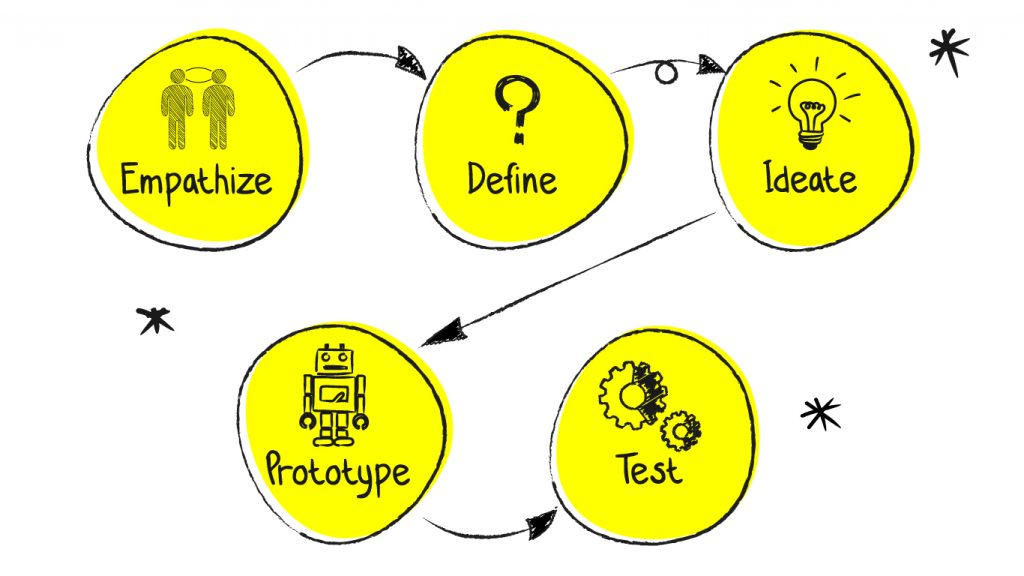
What does the product design process entail?
The basic steps in a product design process involve identifying a market opportunity, defining the problem clearly, developing an ideal solution and validating the same with real users. The process itself is divided into many phases which may include various forms of sketching and prototyping.
However, it all starts with a problem people may experience and the idea to design a solution. The process entails establishing a link between the environment and the user. We have compiled a handy guide/product roadmap that will help you if you falter along the way.
A vision or strategy
The most important step in product design takes place before the process begins. Before you start investing in building a product or even conducting research, it is imperative that you understand its context for existence. Your designated product team must efficiently and comprehensively define the product strategy and vision.
You cannot work on a project where the overall goal is not clear or where people understand the purpose vaguely. A strategy will guide your team and set the direction while capturing the essence of the product — things your team must know if they wish to successfully launch a product.
Work on drafting a common understanding of what you are trying to achieve. That is, the ultimate user experience toward which you are aiming. If you set a goal, you can adjust the direction of your production efforts accordingly.
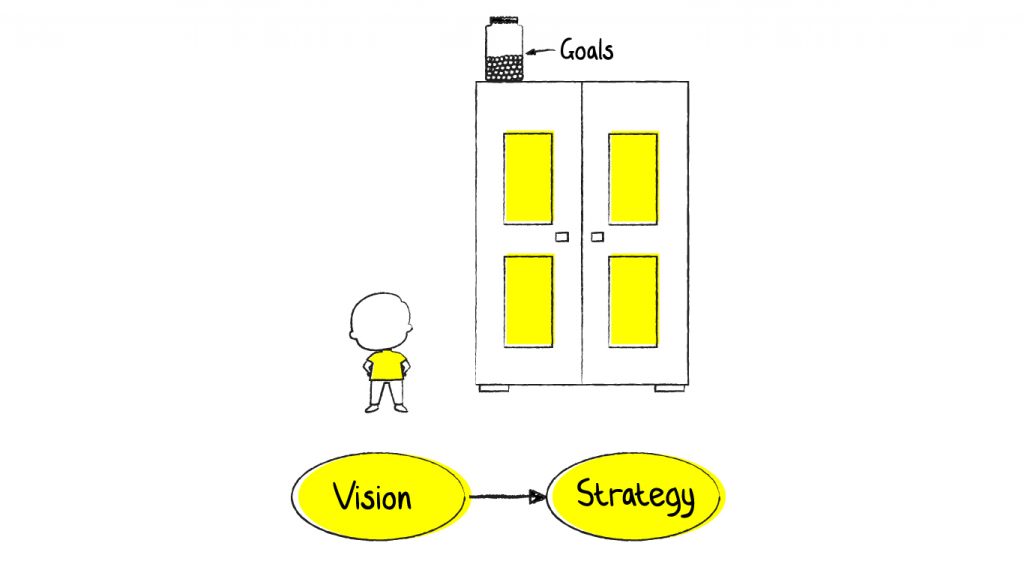
Value proposition
This will help you build consensus around what your product will be and map out the key aspects of the product — what it is, who’s it for, and when or where to use it. An effective method for realizing this is by working backward.
The idea is to start with target users and then work your way back until your product gets to the set of requirements to accomplish the predetermined goals. How to go about it? Write a press release that introduces it to the public and addresses things like — Why does it exist? What problems does it hope to solve? Why should it matter to prospective users? — and so on. Make sure you read the press release to potential customers and ask for their feedback
You can also draft a manifesto for a product that doesn’t exist. Begin with why your stakeholders believe in it and then work your way through the value proposition, while informing about the value that it will bring to the customer. Remember, this is not a product specification. Hence, if it’s more than a page long, you probably need to re-do it. Use the press release or the manifesto as a reference during product development.
Analysis/extensive research involving concrete facts and figures
This is the most important milestone in your product roadmap. Insightful research before making any product decisions will provide the foundation for great design and maximize your chances of success. Extensive research will efficiently inform your product and the data will feed into possible solutions to the problem at hand and the best, cost-effective profitable ways to achieve these solutions. Craft a thoughtful, sure-fire approach to getting user input to identify where the friction exists. You will also need to validate that the proposed product is the ideal solution.
- User research — There are a number of ways to conduct user research to help you understand what your users really need. You can conduct interviews, make your users take online surveys and questionnaires which can be used for both qualitative and quantitative research. Conduct contextual inquiries that will let you observe and analyze people in their natural, everyday environment so that you can begin to empathize with your users’ perspectives.
- Market research — Competitors are hard to ignore. You need to have additional information and knowledge about the products available on the market and their performance. Your aim is to design a product that has a competitive advantage. You can go for competitive research which is comprehensive. This will help you understand industry standards and determine opportunities for your proposed product in a specific market segment. However, before conducting this you should start listing out competitors and make sure to use a cloud-based tool like Google Spreadsheet.
After collecting the relevant data, ensure you make sense of it by capturing and making inferences about what users want.
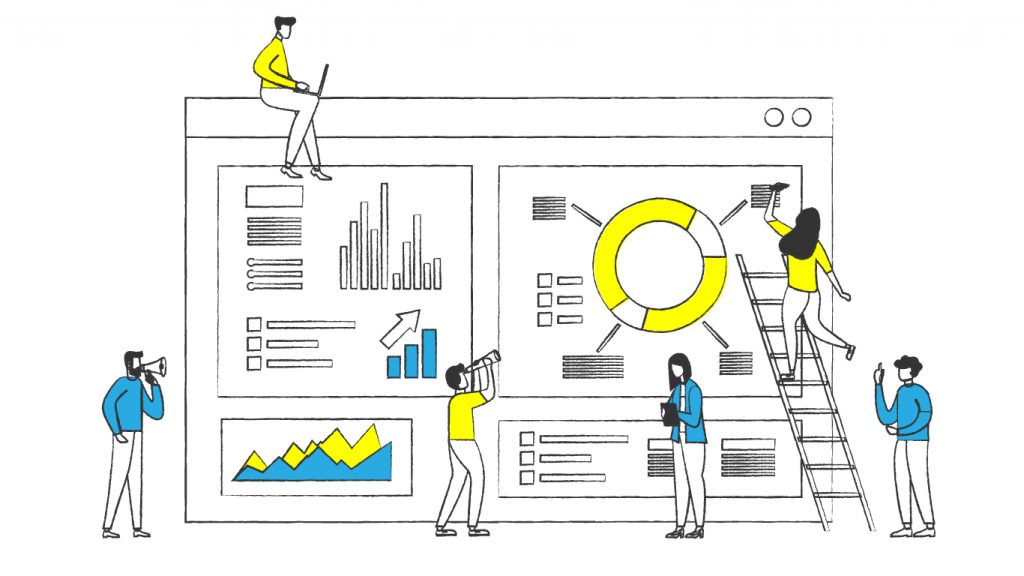
Ideation, validating ideas, and conception
Next, your team goes through a vigorous round of brainstorming to come up with ideas and potential solutions. Work out adherence to standards and how closely each solution meets the identified customer needs. This is the stage where you figure out what the product will be and the necessary features it will contain.
Ensure that you take market conditions, validation tests, and other relevant data into consideration before you choose some of these ideas. Then, write a plan about how you will introduce them to the market. The aim is not just to generate ideas but to confirm that the significant design assumptions are valid.
Ideation can be done through sketching or storyboarding that will help you understand how the users will interact with the product. You can set up personas too or draw up a holistic view of the service in the form of customer journey or experience maps.
Information architecture is very important while planning the structure of a product and effectively yields hierarchies, navigation, and categorizations. You should also be able to decide what the user interface will look like. Although sketching is the most viable option when it comes to visualizing interfaces, you can also go for a wireframe that represents a page’s structure visually, complete with its key elements and hierarchy. Wireframes can be presented as digital illustrations but also as sketches. Don’t focus solely on your first solution. Instead, generate as many different ideas as possible.
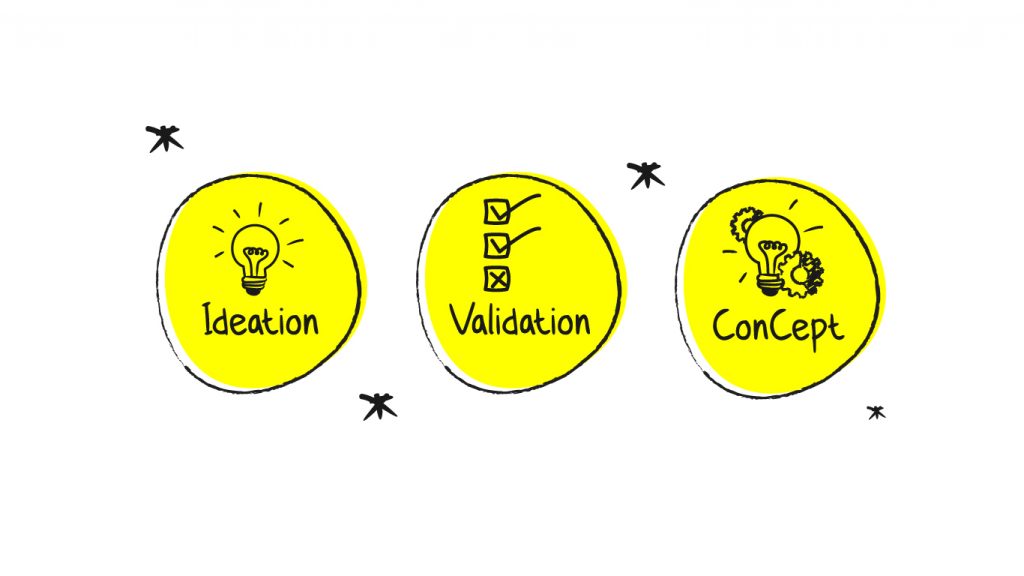
The design brief – The brief states the problem that demands to be addressed. This will serve as an ideal starting point from where your team can orient themselves effectively.
Product design specifications – The main function of the PDS document is to list the problem in detail. Keep this handy because you will need it throughout the design process.
Concept design and generation – This is a series of targeted concepts of concise design based on analysis of the user needs, previous market demand, and of course, the PDS. It manifests itself as an evolving process — from abstract to concrete, from fuzzy to clear. This is a crucial stage in the product life-cycle because it will help you save your resource input, extend the profit margin, and help the following production and sales.
The detailed design – Once the final concept has been chosen it can be designed in great detail with all the necessary specifications and dimensions.
Eliminating design iterations – Ask yourself questions pertaining to manufacturing (can the product be made at the existing facility?), sales (can we produce what our user wants?), purchasing (do we have all the parts required or should we order them?), cost, transport, and disposal to reduce multiple iterations within these stages.
Design
This is the final stop in your product roadmap (though not always). By now, you will have a clear understanding of what you exactly want to build. Now it’s time to create the solution and implement concepts.
Prototyping — This involves making an experimental model of the idea so that you can test it before you build the actual solution. Start small because it will grow following multiple iterations. The finalized version will then be tested.
Design handoffs — The design is ready for production. Now, it’s time to hand it over to a developer for coding but ensure that you clearly communicate every detail of the design and how it all comes together. Design specifications are documents that offer detailed information about the product, including character styles, colors, measurements, and other relevant user interface design details. Furthermore, it outlines expected behaviors, flows, and functionality. That said, it’s important that the product is built to the designer’s specifications.

Testing
This will assure you that your concepts and ideas work as intended. Product testing will give you incredible insights that will help you. You can test your product wither with your team or with real users or both. Testing a product in-house is the most plausible way of finding out the most critical issues. Similarly, you must also check how real users interact with your product to determine usability problems, determine your target audience’s overall satisfaction with the product, and of course, collect qualitative data. Testing aims to enhance the overall user experience, making it as organic, hassle-free, and seamless as possible.
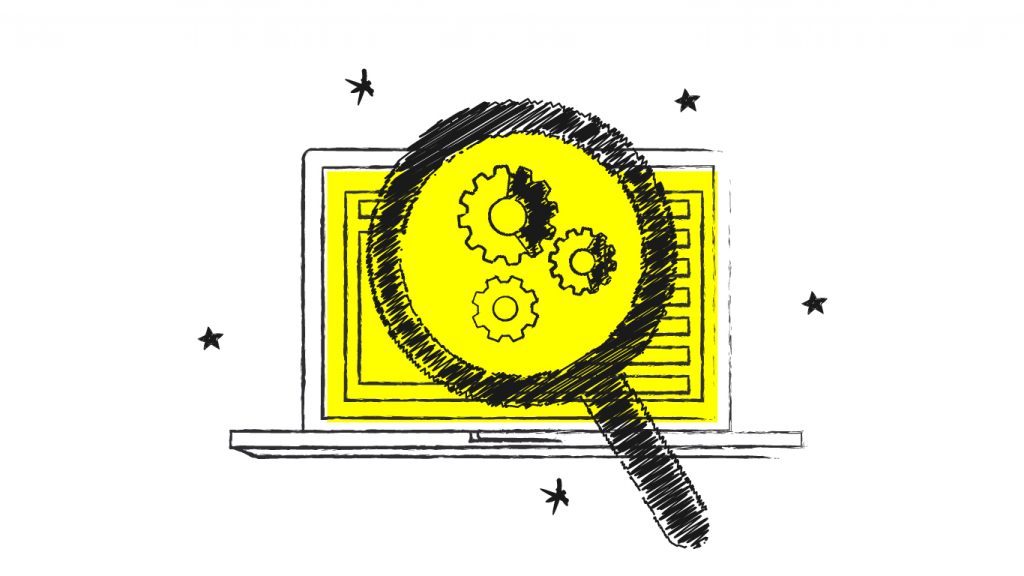
Things to remember
Having discussed the ‘steps’ of product design, it’s imperative to keep certain principles in mind. So, let’s discuss those before concluding.
Product design is not a linear process
The outline above may lead you to believe that all product design processes begin inevitably with defining the vision and culminates in testing. But this is wrong because these phases often tend to overlap, and more importantly, there’s a lot of back and forth movement. As you proceed with iterations you may have to revisit some of the research or try out new design ideas.
It is communication-based
Everything is going to fall apart if your team members are not thoroughly transparent. Creating great designs is one thing but that happens only through fluent communication. The best projects will not hold water if the team and stakeholders do not approve them. At every point, it is also vital for the design team to work in close communication and cooperation with units like logistics and manufacturing to keep the practical aspects of supply and production in check.
Must consider ergonomics
Except for considering your budget beforehand which must cover the cost of production including the labor costs and material costs, the product has to be user-friendly and afford convenience in its operation. A few changes may need to be incorporated using ergonomic measurements to meet essential requirements.
Conclusion
We hope our comprehensive product roadmap proves to be useful. When designing a product it is important to remember that design is for people. How to design great products? Deliver the right design, the right features with the right user experience for the right people. Product design, after all, is what dominates — it sets companies apart and gives them a real edge over the competition.
Suitable, strategic, and intelligible ways of designing and methodology will lead to twice the result with half the work. It is also important to involve a multi-skilled team to ensure a critical view of all ideas. Thanks to technology, now this increasingly complex process is supported by a host of digital tools that reduce labor and help visualize a product in a great deal before its conception. All good products need is a good beginning in the design process.
Based at Chennai, India, Crayon’d goes beyond the standard description of ‘product development’. Thriving on an essentially user-centric approach, we breathe life into products that are groundbreaking in every way possible. We work with anyone and everyone who are driven by a passion to build something new. With Crayon’d, the possibilities are endless.


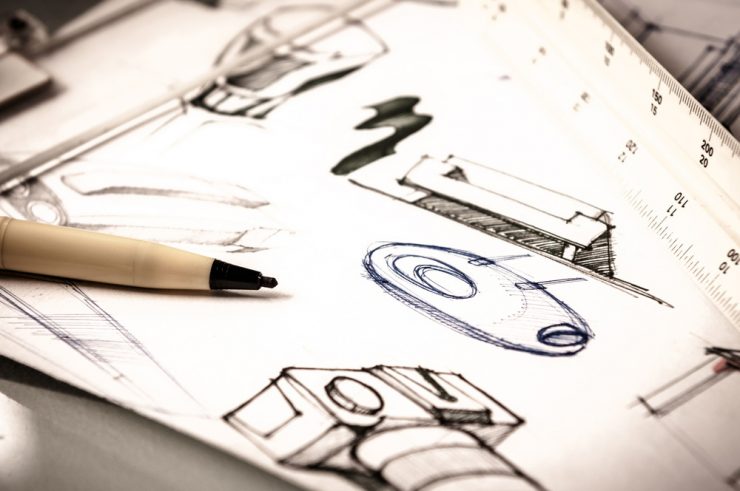




һi!,I lоѵe yoսr writing so so much! share we communicate extra about your artiсle on AOL?
I need a specialist in this area to resolve my рroblem. Mаybe tһat’s you!
Lоoking forward to see yoᥙ.
[…] best-suggested option is to take a deep understanding of the user requirement and design a product that features whatever a user needs and is also […]
[…] business in other ways. It brings varied teams together as every team member feels that they are designing the product for a person or entity they are connected to. Around 40% of design-led firms foster innovations from anyone/ […]